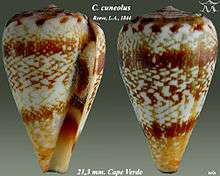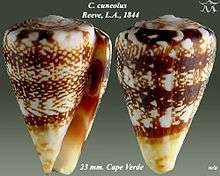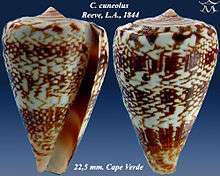Conus cuneolus
Conus cuneolus is a species of sea snail, a marine gastropod mollusk in the family Conidae, the cone snails and their allies.[2]
| Conus cuneolus | |
|---|---|
 | |
| Apertural and abapertural views of shell of Conus cuneolus Reeve, L.A., 1844 | |
 | |
| Scientific classification | |
| Kingdom: | Animalia |
| Phylum: | Mollusca |
| Class: | Gastropoda |
| Clade: | Caenogastropoda |
| Clade: | Hypsogastropoda |
| Clade: | Neogastropoda |
| Superfamily: | Conoidea |
| Family: | Conidae |
| Genus: | Conus |
| Species: | C. cuneolus |
| Binomial name | |
| Conus cuneolus Reeve, 1843 | |
| Synonyms[2] | |
| |
Like all species within the genus Conus, these snails are predatory and venomous. They are capable of "stinging" humans, therefore live ones should be handled carefully or not at all.
Description
The size of the shell varies between 17 mm and 33 mm. The shell is shortly turbinated, wide at the shoulder, and somewhat inflated. Its color is chestnut- or chocolate-brown, with small white maculations, forming an obscure band at the shoulder, and another below the middle, as well as somewhat scattered over the rest of the surface, including the convex spire.
Distribution
This species occurs in the Atlantic Ocean off the Cape Verdes, where it is restricted to the southwestern part of the island of Sal.[1]
References
- Tenorio, M.J. (2012). "Conus cuneolus". IUCN Red List of Threatened Species. 2012: e.T192403A2088649. doi:10.2305/IUCN.UK.2012-1.RLTS.T192403A2088649.en.
- Conus cuneolus Reeve, 1843. Retrieved through: World Register of Marine Species on 7 December 2018.
- Afonso C.M.L. & Tenorio M.J. (2004) Conus cuneolus Reeve, 1843 and related species in Sal Island, Cape Verde Archipelago (Gastropoda, Conidae). Visaya 1(1
- Tucker J.K. & Tenorio M.J. (2009) Systematic classification of Recent and fossil conoidean gastropods. Hackenheim: Conchbooks. 296 pp.
- Puillandre N., Duda T.F., Meyer C., Olivera B.M. & Bouchet P. (2015). One, four or 100 genera? A new classification of the cone snails. Journal of Molluscan Studies. 81: 1–23

External links
- The Conus Biodiversity website
- Cone Shells – Knights of the Sea
- "Africonus cuneolus". Gastropods.com. Retrieved 15 January 2019.
| Wikimedia Commons has media related to Conus cuneolus. |
